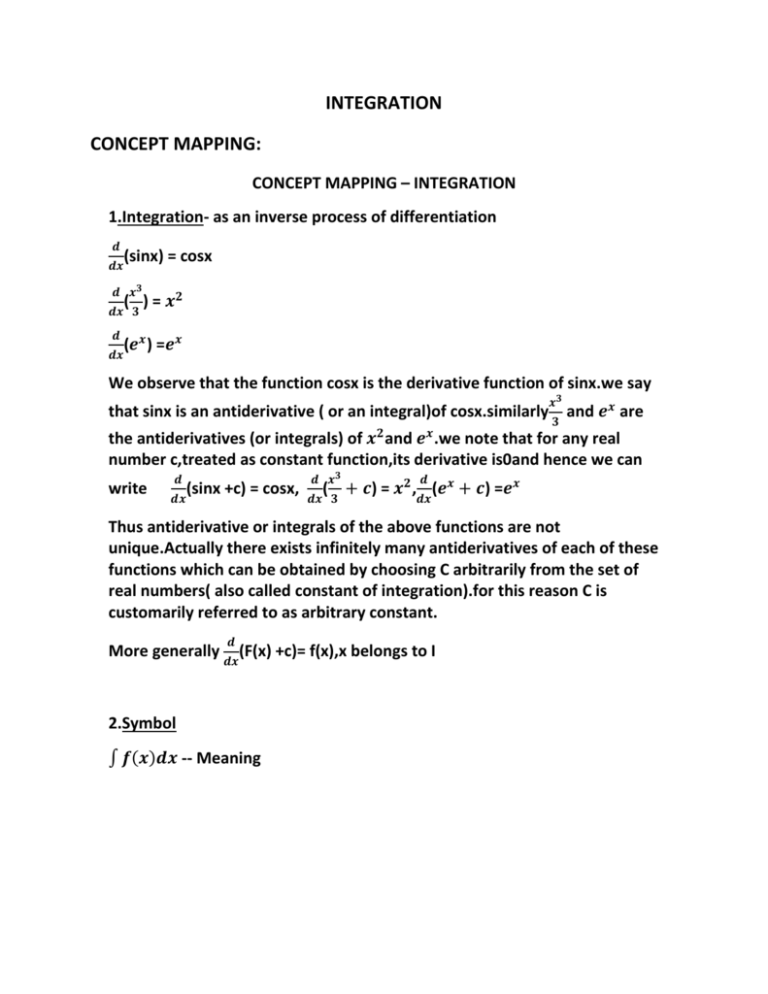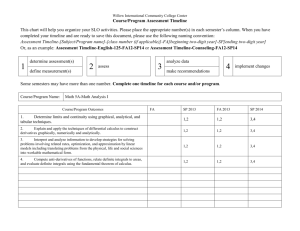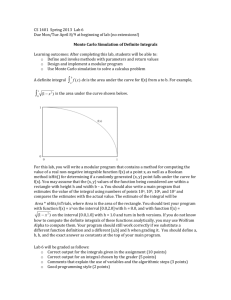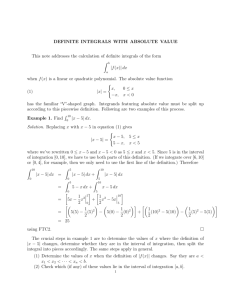Evaluate - e-CTLT
advertisement

INTEGRATION CONCEPT MAPPING: CONCEPT MAPPING – INTEGRATION 1.Integration- as an inverse process of differentiation 𝒅 𝒅𝒙 (sinx) = cosx 𝒅 𝒙𝟑 ( ) = 𝒙𝟐 𝒅𝒙 𝟑 𝒅 𝒅𝒙 (𝒆𝒙 ) =𝒆𝒙 We observe that the function cosx is the derivative function of sinx.we say that sinx is an antiderivative ( or an integral)of cosx.similarly 𝒙𝟑 𝟑 and 𝒆𝒙 are the antiderivatives (or integrals) of 𝒙𝟐 and 𝒆𝒙 .we note that for any real number c,treated as constant function,its derivative is0and hence we can write 𝒅 𝒅𝒙 (sinx +c) = cosx, 𝒅 𝒙𝟑 𝒅 𝒅𝒙 𝟑 𝒅𝒙 ( + 𝒄) = 𝒙𝟐 , (𝒆𝒙 + 𝒄) =𝒆𝒙 Thus antiderivative or integrals of the above functions are not unique.Actually there exists infinitely many antiderivatives of each of these functions which can be obtained by choosing C arbitrarily from the set of real numbers( also called constant of integration).for this reason C is customarily referred to as arbitrary constant. More generally 𝒅 𝒅𝒙 (F(x) +c)= f(x),x belongs to I 2.Symbol ∫ 𝒇(𝒙)𝒅𝒙 -- Meaning 3.Comparison between differentiation and integration a. Both are operations on function b. All functions are not differentiable c.All functions are not integrable d .Derivative of a function when it exists it is unique function but the integral of of a function is not so. However they are unique upto an additive constant ie.any two integrals of a function differ by a constant. e. When a polynomial function P(x) is differentiated the result is a polynomial whose degree is one less than the degree of p(x) eg. 𝒅 𝒅𝒙 (𝒙𝟐 ) = 2x When a polynomial function is integrated the result is a polynomial whose Degree is one more than that of p(x) 𝒙𝟒 Eg.∫ 𝒙𝟑 dx = + c 𝟒 f. The derivative of a function has a geometrical meaning- the slope of the tangent to the corresponding curve at a point g.Integration- family of curves placed parallel to each other having parallel tangents at the point of intersection of the curves of the family ,with the lines perpendicular to the axis representing the variable of integration. 4.Methods of integration Methods of integration 1. Integration by direct method ↓ ↓ Integration by Integration by Substitution parts ↓ Integration using Partial fraction ↓ ↓ Application of Function ↓ Partial fraction ∫ 𝒖𝒅𝒗=uv-∫ 𝒗𝒅𝒖 𝒑𝒙+𝒒 Trigonometric function(𝒙−𝒂)(𝒙−𝒃) (𝒑𝒙+𝒒) In integrals (𝒙−𝒂)𝟐 𝑨 𝑨 (𝒙−𝒂) Integration of some + 𝑩 (𝒙−𝒃) + 𝒑𝒙𝟐 +𝒒𝒙+𝒓 - +𝒃𝒙+𝒄 - 𝑨 (𝒙−𝒂) 𝑨 (𝒙−𝒂) 𝒙𝟐 ±𝒂𝟐 𝒅𝒙 ∫ 𝒂𝟐−𝒙𝟐,∫ 𝒂𝒙𝟐+𝒃𝒙+𝒄 ∫√ 𝒅𝒙 𝒂𝒙𝟐 +𝒃𝒙+𝒄 ,∫ (𝒙−𝒃) (𝒙−𝒄) 𝒅𝒙 𝒅𝒙 𝑩 𝑪 𝒑𝒙𝟐 +𝒒𝒙+𝒓 Particular function(𝒙−𝒂)(𝒙𝟐 𝒅𝒙 (𝒙−𝒂) + 𝑩 + (𝒙−𝒂)𝟐 (𝒙−𝒃) ∫ 𝒙𝟐±𝒂𝟐,∫ √ 𝑨 (𝒙−𝒂) (𝒙−𝒂)𝟐 𝒑𝒙𝟐 +𝒒𝒙+𝒓 ↓ (𝒙−𝒂)(𝒙−𝒃)(𝒙−𝒄) - - (𝒑𝒙+𝒒)𝒅𝒙 𝒂𝒙𝟐 +𝒃𝒙+𝒄 ,∫ SOME SPECIAL INTEGRALS (𝒑𝒙+𝒒)𝒅𝒙 √𝒂𝒙𝟐 +𝒃𝒙+𝒄 + 𝑩 (𝒙−𝒂)𝟐 + + 𝑪 (𝒙−𝒃) 𝑩𝒙+𝑪 𝒙𝟐 +𝒃𝒙+𝒄 1.∫ √𝒂𝟐 ± 𝒙𝟐 dx 2.∫ √𝒙𝟐 − 𝒂𝟐 dx 3.∫ √𝒂𝒙𝟐 + 𝒃𝒙 + 𝒄dx 4.∫(𝒑𝒙 + 𝒒)√𝒂𝒙𝟐 + 𝒃𝒙 + 𝒄dx Definite Integrals 𝒃 ∫𝒂 𝒇(𝒙)𝒅𝒙 - Area of the region bounded by the curve y=f(x) and the ordinates x=a,x=b and x-axis 𝒃 Calculating ∫𝒂 𝒇(𝒙)𝒅𝒙 Find the indefinite integral ∫ 𝒇(𝒙)𝒅𝒙 .Let this be F(x) 𝒃 ∫𝒂 𝒇(𝒙)𝒅𝒙 = F(b) –F(a) Definite integrals ↓↓↓↓ Definite integrals based on Definite integrals Properties of integration types of indefinite integrals as a limit of sum definite integral of modulus fn . Some important results. 1.∫ 𝒙𝒏 𝒅𝒙 = 𝒙𝒏+𝟏 𝒏+𝟏 +c 2.∫ 𝟏𝒅𝒙 = x+c 3.∫ 𝒔𝒊𝒏𝒙 𝒅𝒙 = -cosx +c 4.∫ 𝒄𝒐𝒔𝒙𝒅𝒙 = sinx +c 5.∫ 𝒔𝒆𝒄𝟐 x dx = tanx + c 6.∫ 𝒄𝒐𝒔𝒆𝒄𝟐 x dx = -cotx +c 7.∫ 𝒔𝒆𝒄𝒙 𝒕𝒂𝒏𝒙 𝒅𝒙 = secx + c 8.∫ 𝒄𝒐𝒔𝒆𝒄𝒙 𝒄𝒐𝒕𝒙 𝒅𝒙 = - cosecx + c 9.∫ √ 𝟏 𝟏− 𝒙𝟐 dx = -𝐜𝐨𝐬 −𝟏 𝒙 +c OR 𝐬𝐢𝐧−𝟏 𝒙 +c 𝟏 10.∫ dx =𝐭𝐚𝐧−𝟏 𝒙 +c OR -𝐜𝐨𝐭 −𝟏 𝒙 +c 𝟏+𝒙𝟐 11.∫ 𝒅𝒙 𝒙√𝒙𝟐 −𝟏 = 𝐬𝐞𝐜 −𝟏 𝒙 +c OR -𝐜𝐬𝐜 −𝟏 𝒙 +c 12.∫ 𝒆𝒙 dx = 𝒆𝒙 + c 𝟏 13.∫ dx =log x +c 𝒙 𝒂𝒙 14.∫ 𝒂𝒙 dx = +c 𝒍𝒐𝒈𝒂 15.∫ 𝒆𝒙 ( f(x) +f ’(x) ) dx = 𝒆𝒙 f(x) +c Some Properties of Definite Integrals 𝒃 𝒃 𝑷𝟎 :∫𝒂 𝒇(𝒙)𝒅𝒙 = ∫𝒂 𝒇(𝒕)𝒅𝒕 𝒃 𝒂 𝑷𝟏 :∫𝒂 𝒇(𝒙)𝒅𝒙 = − ∫𝒃 𝒇(𝒙)𝒅𝒙 𝒃 𝒄 𝒃 𝑷𝟐 :∫𝒂 𝒇(𝒙)𝒅𝒙=∫𝒂 𝒇(𝒙)𝒅𝒙 + ∫𝒄 𝒇(𝒙)𝒅𝒙 𝒃 𝒃 𝑷𝟑 :∫𝒂 𝒇(𝒙)𝒅𝒙 = ∫𝒂 𝒇(𝒂 + 𝒃 − 𝒙)𝒅𝒙 𝒂 𝒂 𝑷𝟒 ∫𝟎 𝒇(𝒙)𝒅𝒙 = ∫𝟎 𝒇(𝒂 − 𝒙)𝒅𝒙 𝟐𝒂 𝒂 𝒂 𝑷𝟓 :∫𝟎 𝒇(𝒙)𝒅𝒙 = ∫𝟎 𝒇(𝒙)𝒅𝒙+∫𝟎 𝒇(𝟐𝒂 − 𝒙)𝒅𝒙 𝟐𝒂 𝒂 𝑷𝟔 :∫𝟎 𝒇(𝒙)𝒅𝒙 = 𝟐 ∫𝟎 𝒇(𝒙)𝒅𝒙,If f(2a-x)=f(x) =0 if f(2a-x)=-f(x) 𝑷𝟕:(𝒊) ∫𝒂 −𝒂 𝒂 𝒇(𝒙)𝒅𝒙=𝟐 ∫𝟎 𝒇(𝒙)𝒅𝒙, If f is an even function 𝒂 (ii)∫−𝒂 𝒇(𝒙)𝒅𝒙 = 𝟎 𝑰𝒇 𝒊𝒔 𝒂𝒏 𝒐𝒅𝒅 𝒇𝒖𝒏𝒄𝒕𝒊𝒐𝒏 Limit as a sum 𝒃 3. ∫𝒂 𝒇(𝒙)dx = 𝐥𝐢𝐦 𝒉 ( f(a) + f(a+h)+f (a+2h)+…………+f(a+(n-1)h) 𝒉→𝟎 ∑ 𝒏 = 𝟏 + 𝟐 + 𝟑 + 𝟒 + ⋯ = n (n+1)/2 ∑ 𝒏𝟐 = 𝟏𝟐 + 𝟐𝟐 + 𝟑𝟐 + 𝟒𝟐 + ⋯ + 𝒏𝟐 = n (n+1) (2n+1)/6 ∑ 𝒏𝟑 = 𝟏𝟑 + 𝟐𝟑 + 𝟑𝟑 + 𝟒𝟑 + ⋯ + 𝒏𝟑 = [ 𝐧(𝐧 + 𝟏)/𝟐]𝟐 𝒂 + 𝒂𝒓 + 𝒂𝒓𝟐 + 𝒂𝒓𝟑 + ⋯ + 𝒂𝒓𝒏 = a(𝒓𝒏 − 𝟏)/(𝒓 − 𝟏) r≠ 1 LEVEL 1. 𝟏 √𝟐 1. Evaluate:∫𝟎 𝟏 𝒅𝒙. √𝟏−𝒙𝟐 𝝅 ANS. 𝟒 2. Evaluate:∫ 𝒄𝒐𝒔√𝒙 √𝒙 3. Evaluate:∫ 4. 𝐝𝐱. 𝒔𝒊𝒏√𝒙 √𝒙 Ans. 𝒅𝒙. Write a value of ∫ Ans. 𝟏 √𝟒−𝒙𝟐 𝒅𝒙. Ans. 𝐬𝐢𝐧−𝟏 𝟐𝒙 + 𝒄 5. Find f(x) satisfying the following :∫ 𝒆𝒙 (𝒔𝒆𝒄𝟐 𝒙 + 𝐭𝐚𝐧 𝒙)𝒅𝒙 = 𝒆𝒙 𝒇(𝒙) + 𝒄. Ans. F(x) = tan x 𝟓𝒙 6. Evaluate : ∫ 𝟓𝒙 𝒅𝒙. Ans. 𝒍𝒐𝒈𝟓 + 𝒄 𝝅/𝟐 7. Write the value of ∫−𝝅/𝟐 𝒔𝒊𝒏𝟓 𝒙𝒅𝒙 Ans. zero 8. (𝒂𝒙+𝒃) ∫(𝒂𝒙 + 𝒃)𝟑 𝒅𝒙 Ans. 𝟒𝒂 9. Evaluate : ∫ √ 10. Evaluate : ∫ 𝟐 𝒅𝒙 𝟏−𝒙𝟐 (𝐥𝐨𝐠 𝒙)𝟐 𝒙 +𝒄 Ans. 𝐬𝐢𝐧−𝟏 𝒙 + 𝒅𝒙 11. Evaluate:∫𝟎 √𝟒 − 𝒙𝟐 𝒅𝒙 𝒙 𝟒 𝒄 Ans. (𝒍𝒐𝒈𝒙)𝟑 + 𝒄 Ans 𝝅 x 12. Given ∫ 𝒆 (tan x + 1) sec x dx = e f(x) + c. then f(x) =? Ans. secx LEVEL II: 𝜋 𝑥 𝑠𝑖𝑛𝑥 𝑑𝑥 1+𝑐𝑜𝑠2 𝑥 1. Evaluate.∫0 𝜋 𝑥 tan 𝑥 𝑑𝑥 2. Evaluate: ∫0 3. Evaluate: ∫02 √𝑡𝑎𝑛𝑥 + √𝑐𝑜𝑡𝑥 sec 𝑥 𝑐𝑜𝑠𝑒𝑐 𝑥 𝜋 𝜋 4. Evaluate:∫02 𝑙𝑜𝑔 sin 𝑥 𝑑𝑥 . 𝑒𝑥 5.Evaluate:∫ √5−4𝑒 𝑥 2𝑥 dx −𝑒 (𝑥−4) 6. Evaluate: ∫ 𝑒 𝑥 𝑑𝑥 (𝑥−2)3 𝜋 7. Evaluate :∫0 8. Evaluate: ∫ 𝑒 𝑐𝑜𝑠𝑥 𝑑𝑥 𝑒 𝑐𝑜𝑠𝑥 +𝑒 −𝑐𝑜𝑠𝑥 𝑑𝑥 √5−4𝑥−𝑥 2 9. Evaluate:∫ 𝑥 sin−1 𝑥 𝑑𝑥 LEVEL III: 𝑎 𝑎−𝑥 1. Evaluate: ∫−𝑎 √ 𝑑𝑥 𝑎+𝑥 𝜋 𝑥𝑠𝑖𝑛𝑥 2. Evaluate: ∫0 1+𝑐𝑜𝑠 2 𝑥 𝑑𝑥 3. 1 Evaluate: ∫0 cot −1 (1 − 𝑥 + 𝑥 2 ) 𝑑𝑥 𝜋 4. Evaluate: ∫0 𝑥 𝑡𝑎𝑛𝑥 𝑠𝑒𝑐𝑥+𝑡𝑎𝑛𝑥 𝑑𝑥 Evaluate: ∫ 𝑥 𝑑𝑥 𝑎2 𝑐𝑜𝑠2 𝑥+𝑏2 𝑠𝑖𝑛2 𝑥 𝜋 𝑑𝑥 3 𝜋 1+√𝑡𝑎𝑛𝑥 6 5. Evaluate: ∫ 𝒙𝟒 6. Evaluate:∫ (𝒙−𝟏)(𝒙𝟐 𝒅𝒙 +𝟏) 7. 1 1 Evaluate:∫0 log ( − 1) 𝑑𝑥 𝑥 9. Evaluate: ∫ 𝑥 2 tan−1 𝑥 𝑑𝑥 3𝑥+5 10. Evaluate: ∫ 2 𝑑𝑥 √𝑥 −8𝑥+7 3 11. Evaluate ∫1 (3𝑥 2 + 2𝑥) 𝑑𝑥 using limit as sum. 11. LEVEL 2: PRACTICE QUESTIONS 𝜋 2 1. Evaluate:∫0 𝑥 sin 𝑥+cos 𝑥 𝑑𝑥 2. Evaluate : ∫ 𝑑𝑥. √5−4𝑥−2𝑥 2 −1 3. Evaluate: ∫ 𝑥 𝑠𝑖𝑛 𝑥 𝑑𝑥 4. Evaluate:∫ (sin 𝑥+ cos 𝑥) 𝜋 5.Evaluate :∫0 6. Evaluate :∫ dx √sin 2𝑥 𝑥 tan 𝑥 sec 𝑥 𝑐𝑜𝑠𝑒𝑐 𝑥 𝑑𝑥 . 1 cos(𝑥−𝑎)cos(𝑥−𝑏) 2 𝑑𝑥 7. Evaluate : ∫ 𝑥(𝑙𝑜𝑔 𝑥) 𝑑𝑥. 8. Evaluate : ∫ 𝑥 𝑥 3 −1 𝑑𝑥 𝜋 9. Using properties of definite integral , evaluate:∫0 10. Evaluate:∫ 𝒙+𝟐 √(𝒙−𝟐)(𝒙−𝟑) 𝟓𝒙𝟐 𝟐 11. Evaluate :∫𝟏 𝒙𝟐 +𝟒𝒙+𝟑 𝒅𝒙 𝒅𝒙 𝟏+𝐬𝐢𝐧 𝟐𝒙 12. Evaluate: ∫ 𝒆𝟐𝒙 (𝟏+𝐜𝐨𝐬 𝟐𝒙)𝒅𝒙. 𝟏 13. Evaluate: ∫ 𝐬𝐢𝐧 𝒙−𝐬𝐢𝐧 𝒅𝒙. 𝟐𝒙 𝜋/2 𝑥+sin 𝑥 14. Evaluate :∫0 𝜋/4 15. Evaluate :∫0 1+cos 𝑥 𝑑𝑥 . log(1 + tan 𝑥) 𝑑𝑥 𝑥 4−𝑐𝑜𝑠 2 𝑥 𝑑𝑥. LEVEL 3: PRACTICE QUESTIONS 1. Evaluate:∫ 𝒙𝟐 +𝒙+𝟏 (𝒙+𝟐)(𝒙𝟐 +𝟏) 𝐝𝐱 𝟏 2. Evaluate: ∫ 𝐬𝐢𝐧 𝒙(𝟓−𝟒 𝐜𝐨𝐬 𝒙) 𝟓𝒙+𝟑 3. Evaluate ∫ 𝒅𝒙. 𝒅𝒙 . √𝒙𝟐 +𝟒𝒙+𝟏𝟎 𝟏−√𝒙 4. Evaluate: ∫ √𝟏+ 𝒙 𝒅𝒙. √ 𝑺𝒊𝒏 𝒙+𝐜𝐨𝐬 𝒙 5. Evaluate: ∫ √𝐬𝐢𝐧 𝒙 .𝐜𝐨𝐬 𝒙 𝒅𝒙. 𝟐 𝒙 +𝟏 6. Evaluate: ∫ 𝒆𝒙 ((𝒙+𝟏) 𝟐 )𝒅𝒙. 𝟐 7. Evaluate:∫𝟏 (𝒙𝟐 + 𝒙 + 𝟐)dx as a limit of sums. 𝟏 8. Evaluate :∫𝟎 𝐬𝐢𝐧−𝟏(𝒙√𝟏 − 𝒙 − √𝒙√𝟏 − 𝒙𝟐 ) 𝒅𝒙 , 𝟎 ≤ 𝒙 ≤ 𝟏. 𝟑 9. Evaluate :∫𝟏 (𝟐𝒙𝟐 + 𝟑)𝒅𝒙 as limit of sums. 𝝅 𝒙 𝐬𝐢𝐧 𝒙 𝐜𝐨𝐬 𝒙 10. Evaluate :∫𝟎𝟐 𝒔𝒊𝒏𝟒𝒙+𝒄𝒐𝒔𝟒𝒙 𝒅𝒙. 𝝅/𝟑 11. Evaluate :∫𝝅/𝟔 12. Evaluate:∫ 𝒅𝒙 𝟏+√𝒕𝒂𝒏𝒙 𝟔𝒙+𝟕 √(𝒙−𝟓)(𝒙−𝟒) 𝟏 𝒅𝒙. 𝟏 13. Evaluate:∫𝟎 𝐥𝐨𝐠 ( − 𝟏) 𝒅𝒙. 𝒙 14. Evaluate: ∫ 𝒙 𝐬𝐢𝐧−𝟏 𝒙 𝒅𝒙 √𝟏−𝒙𝟐 (𝒙𝟐 +𝟏)(𝒙𝟐 +𝟒) 15. Evaluate :∫ (𝒙𝟐+𝟑)(𝒙𝟐−𝟓) 𝒅𝒙. 𝟐 𝟏 16. Evaluate:∫𝟎 𝒙(𝒕𝒂𝒏 −𝟏 𝒙) 𝒅𝒙. 𝒙 17. Evaluate:∫𝟎𝒂 𝐬𝐢𝐧−𝟏 √𝒂+𝒙 𝒅𝒙. 18. Evaluate: ∫ 𝐥𝐨𝐠(𝐬𝐢𝐧 𝒙) 𝐭𝐚𝐧 𝒙 𝒅𝒙 −𝟏 𝒙 𝒆𝐭𝐚𝐧 19. Evaluate:∫ dx. (𝟏+𝒙𝟐 )𝟐 STRATEGIES TO ACHIEVE QUALITATIVE AND QUANTITAIVE RESULTS IN MATHEMATICS CLASS XII Strategies for Slow learners: 1. Identify the slow learners at the beginning of the year. Set achievable targets and motivate them throughout the year so that they will not be depressed and discouraged. 2. Question papers of last five years (both main and supplementary examinations) are to be collected and the list out all repeated, important concepts/problems. The slow learners are to be given sufficient practice in these areas/concepts. 3. The strengths and weaknesses are to be diagnosed in these areas. Thorough revision in these concepts is to be given by conducting frequent slip tests and re-teaching. 4. Preparation of Question-wise analysis of each examination including slip tests to be done to locate the weak areas and thorough revision is to be conducted. 5. Collect the drilling problems of a particular concept, and solve two or three problems in the class. Then allow the slow learners to solve the remaining problems as per their capacity to attain a good command and confidence over that particular method/type (Drilling Exercises). 6. Three model papers based on the Sample Papers issued by CBSE (SET I, II, III) along with marking scheme should be prepared by the teacher. Copies of these papers are to be issued to all the slow learners. This will help the child to know the type of questions/methods important for board exams. They will get more confidence to face the board exam. 7. Concept wise, specially designed home assignments are to be given to students daily. The assignments are to be corrected by giving proper suggestions in front of students. 8. After the completion of each concept/topic allow the low achiever to solve the problem pertaining to that method. If possible every day at least one low achiever should come on to the board to solve a problem. 9. Whenever possible, teach Mathematics by using PP Presentations in an effective way. 10. Weekly test pertaining to these formulae has to be conducted regularly. 11. The students have to be asked to read the entire text book thoroughly. 12. The students are to be made aware about the chapter wise distribution of marks or marking scheme. 13. Sufficient tips should be given for time management. 14. Few easy topics are to be identified from examination point of view and are to be assigned to the slow learners. The slow learners are to be prepared for reduced, identified syllabus. Strategies for bright and Gifted Student: 15. Bright Children are the back bones to improve the overall Performance Index of the Vidyalaya. So they should be encouraged by providing concepts wise HOTS questions. They should be encouraged to solve more challenging questions which have more concepts and challenging tasks. More thought provoking questions are to be collected and a question bank is to be given to gifted students to develop their analyzing and reasoning capabilities. 16. Instead of preparing the PP presentation by the teacher, better to handover all the necessary content to the students and ask the bright students, to prepare one PPT each. After submission of completed PP Presentation, check the PPT and the same can be used effectively in the teaching learning process. 17. On completion of syllabus topic wise revision plan is to be framed for both slow learners and gifted students. 18. The students have to be asked to read the entire text book thoroughly. 19. The students are to be made aware about the chapter wise distribution of marks or marking scheme. 20. Sufficient tips should be given for time management. Revision Plan: After completion of coverage of syllabus, proper revision plan is to be prepared Concept-wise (questions for slow learners/gifted students), HOTS questions/optional exercises (for gifted students) is to be prepared and given to the students. Minimum learning programme for slow learners is to be prepared and identified/reduced syllabus is to assigned to slow learners. CBSE Board pattern question papers (at least 10 papers should be solved) CBSE Board papers 2010 (3 sets) CBSE Board Compartment Paper 2011 (1 set) CBSE Board papers 2012. 2013, 2014 (3 sets) CBSE Board Compartment Paper 2013 (1 set) Common Pre-board Board Examination 2013, 2014 (2 sets) CBSE sample papers









